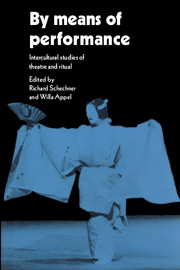Book contents
- Frontmatter
- Contents
- List of figures
- Notes on contributors
- Concerning Victor Turner
- Introduction
- 1 Are there universals of performance in myth, ritual, and drama?
- 2 Magnitudes of performance
- 3 Liminality: a synthesis of subjective and objective experience
- 4 The Yaqui deer dance at Pascua Pueblo, Arizona
- 5 A Yaqui point of view: on Yaqui ceremonies and anthropologists
- 6 Performance of precepts/precepts of performance: Hasidic celebrations of Purim in Brooklyn
- 7 The significance of performance for its audience: an analysis of three Sri Lankan rituals
- 8 What does it mean to “become the character”: power, presence, and transcendence in Asian in-body disciplines of practice
- 9 Korean shamans: role playing through trance possession
- 10 The practice of noh theatre
- 11 The profanation of the sacred in circus clown performances
- 12 Ethnographic notes on sacred and profane performance
- 13 The spatial sense of the sacred in Spanish America and the American South and its tie with performance
- 14 Space and context
- 15 The transformation of consciousness in ritual performances: some thoughts and questions
- 16 Universals of performance; or amortizing play
- Appendix
- Bibliography
- Index
2 - Magnitudes of performance
Published online by Cambridge University Press: 05 June 2012
- Frontmatter
- Contents
- List of figures
- Notes on contributors
- Concerning Victor Turner
- Introduction
- 1 Are there universals of performance in myth, ritual, and drama?
- 2 Magnitudes of performance
- 3 Liminality: a synthesis of subjective and objective experience
- 4 The Yaqui deer dance at Pascua Pueblo, Arizona
- 5 A Yaqui point of view: on Yaqui ceremonies and anthropologists
- 6 Performance of precepts/precepts of performance: Hasidic celebrations of Purim in Brooklyn
- 7 The significance of performance for its audience: an analysis of three Sri Lankan rituals
- 8 What does it mean to “become the character”: power, presence, and transcendence in Asian in-body disciplines of practice
- 9 Korean shamans: role playing through trance possession
- 10 The practice of noh theatre
- 11 The profanation of the sacred in circus clown performances
- 12 Ethnographic notes on sacred and profane performance
- 13 The spatial sense of the sacred in Spanish America and the American South and its tie with performance
- 14 Space and context
- 15 The transformation of consciousness in ritual performances: some thoughts and questions
- 16 Universals of performance; or amortizing play
- Appendix
- Bibliography
- Index
Summary
A figure for all genres
At the descriptive level there is no detail of performance that occurs everywhere under all circumstances. Nor is it easy to specify limitations on what is, or could be treated as, performance. Figure 2.1 is an exemplary but somewhat serendipitous panorama of just how diverse and extensive the performance world is. Criteria for inclusion in the chart were: (1) events called performances in this or that culture; (2) events treated “as performance“ by scholars. I limited myself as much as possible to events that I have either seen or studied. I wanted to fight the tendency to seek “origins” or “sources” in performances below the horizons of fieldwork or reliable historical research. I took my cue from anthropological fieldwork: the evidence I sought was in vivo, close at hand, mostly from the practices of living people. I know that another person could make another time-space-event chart populated by different items. But I believe the outcome would be a similar riot of apparently disparate particulars. What hope is there of unifying such a figure?
If “universals” are wanted, they might be found in processual models explaining how one set of genres, ritual performances for example, become other sets. Does ritual “evolve” into dance, theatre, and sports, and if so how? This search for universals occupied Victor Turner during much of his life.
- Type
- Chapter
- Information
- By Means of PerformanceIntercultural Studies of Theatre and Ritual, pp. 19 - 49Publisher: Cambridge University PressPrint publication year: 1990
- 1
- Cited by



